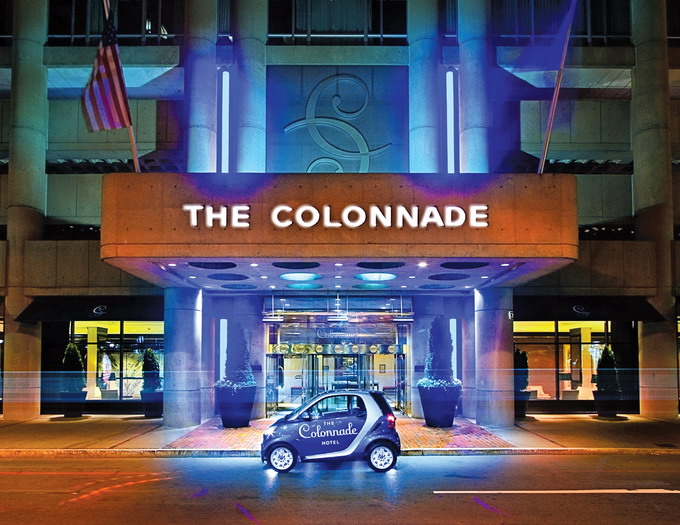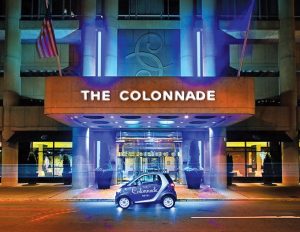When the Colonnade Hotel opened near downtown Boston in 1971, it quickly became one of the city’s most successful business-travel hotels. However, the city’s commercial core seeped outward from the central city into the suburbs and beyond. Coupled with the facility’s age, owner Ron Druker – whose father, Bertram, built the property – realized the need for an upgrade. Beginning in 2006, Druker undertook a $25 million renovation to bolster the hotel’s amenities, accessibility and aesthetics.
Druker hired Selbert Perkins’ Boston office to execute the environmental-graphic design. The firm had recently completed a program for Druker’s adjacent Colonnade residential property. Cliff Selbert, the firm’s co-principal, said, “The Colonnade needed a dramatic entryway element to warm up a somewhat foreboding architectural style. Signage and graphics represented a small portion of the renovation budget – less than 1% overall – but I think the system plays a vital role in creating an updated Colonnade identity.”
Light pipes, which measure 29 ft. tall on either side of the main Colonnade entrance, provide the boldest upgrade. Selbert Perkins teamed with Design Communications Ltd.’s (DCL) Boston branch, which fabricated these and other signage elements.
Mark Andreasson, the office’s president, said neon, LEDs and projections were considered for the pipes’ fabrication. They ultimately decided on LEDs because of their ease of installation and lower maintenance requirements. However, optimizing the viewing angle and providing durability necessary for a high-traffic area required a custom solution.
Starting with Color Kinetics’ iColor Cove RGB LED lighting system, DCL created custom raceways and enclosures. The top pipe measures 20 ft. in length, the lower one 9 ft. Andreasson said, “We didn’t need a full-spectrum, 360° solution, but we wanted a broad projection range. We also didn’t want to install the lightsources at the pipes’ edges, where they could be prone to vandalism and wouldn’t provide quite the same projection effect.”
To enhance the projection, DCL installed diffuser film to ensure consistent illumination and frosted the tubes, which were made from P95 acrylic, to slightly mute the brightness. To protect the pipes, installers also built in kickplates at the base of each pipe to deter vandals or work crews. The pipes also incorporate a DMX controller, which enables color changing and other effects. DCL used a daisy chain to unite the four pipes; and installed the controller in an unobtrusive coat closet. Fred Holland, DCL’s project manager, said, “The controller could create many more effects, but this is a hotel geared towards business travel, so they’ll likely be used conservatively.”
DCL also fabricated and installed a subtle, yet effective, sign above the canopy. Using aluminum angle and perforated sheet, the shop fabricated Selbert Perkins’ curlicue “C” letterstyle using perforated aluminum, which was spec’d both for aesthetics and wind-load tolerance. DCL built the subtle letters from 0.090-in.-thick material with 2-in.-deep returns installed on 1.5-in.-deep stand-offs. Metal-halide lamps illuminate the logo.
Advertisement


 Tip Sheet4 days ago
Tip Sheet4 days ago
 Business Management2 weeks ago
Business Management2 weeks ago
 Women in Signs2 weeks ago
Women in Signs2 weeks ago
 Real Deal5 days ago
Real Deal5 days ago
 Benchmarks22 hours ago
Benchmarks22 hours ago
 Editor's Note1 week ago
Editor's Note1 week ago
 Line Time2 weeks ago
Line Time2 weeks ago
 Product Buying + Technology1 week ago
Product Buying + Technology1 week ago

















